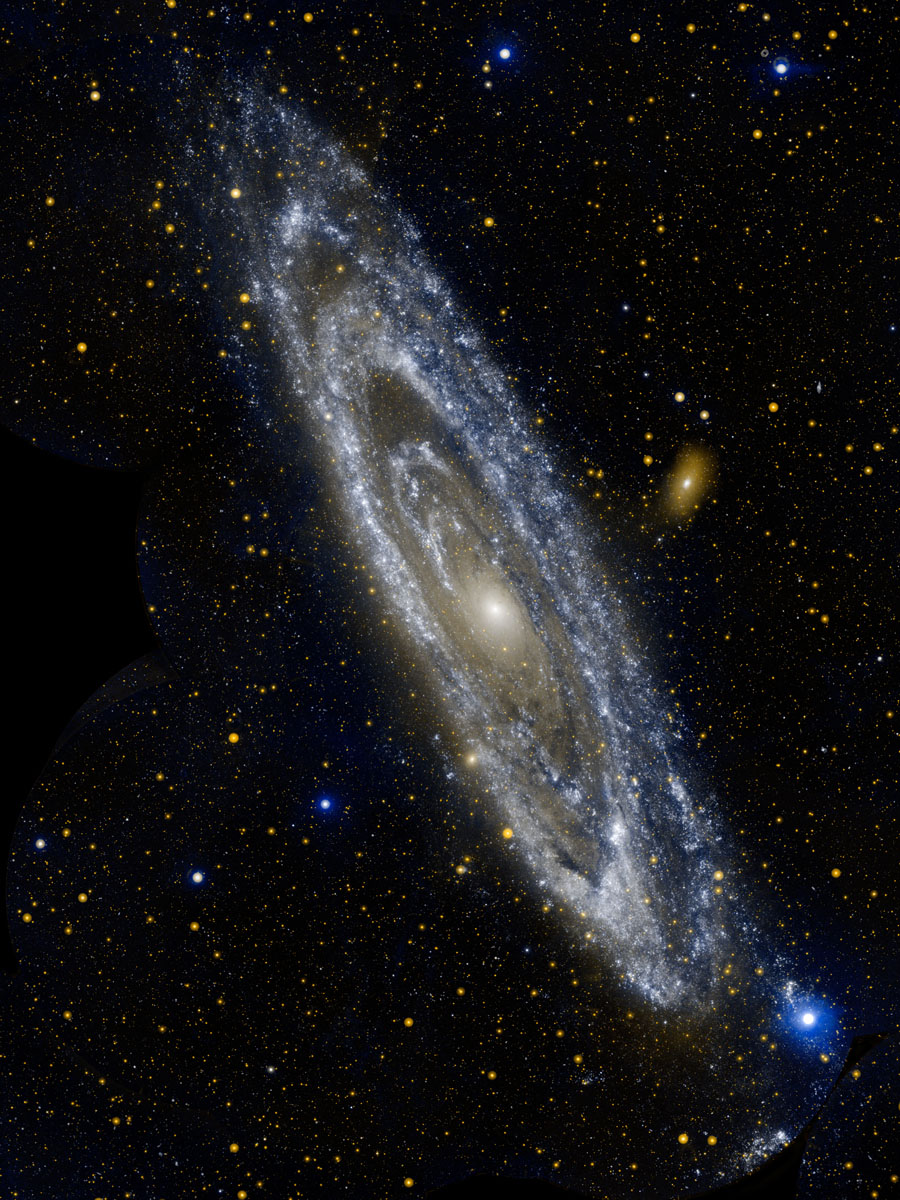Our large neighboring galaxy Andromeda Galaxy got its name from the harbouring constellation Andromeda. It is a somewhat anonymous constellation that feels more like an appendix to the constellation Pegasus. Locating the Andromeda Galaxy normally starts by starting from the Square in the constellation Pegasus.
Along with the Moon and the planets, the Andromeda Galaxy is one of the most popular objects to observe from the northern hemisphere. When Charles Messier made his now famous catalogue of objects that should not be confused with comets, the Andromeda Galaxy was the 31st object in the list; hence the catalogue name M31. The Andromeda Galaxy (M31) is the nearest, larger galaxy to our own galaxy The Milky Way - you could call it our sister galaxy. With its 1000 billion stars (!), It is more than twice as big as the Milky Way and thus our big sister.

M31 photographed with the Galex Space Telescope (Galaxy Evolution Explorer) (Photo: NASA / JPL-Caltech)
The latest research shows that the distance between the two galaxies is about 2.5 million light-years. This means that when we look in the eyepiece, we see the Andromeda Galaxy as it looked 2.5 million years ago. That sounds like a lot, but considering that the diameter of the Andromeda Galaxy is 220,000 light-years and our own Milky Way is over 100,000 light-years, they are not that far apart. The scientists' spectral analyses also show that the two galaxies travel towards each other and will collide in 4-5 billion years. A probable result of the collision is that the galaxies get united in a giant elliptical galaxy.
Despite the enormous size and proximity to us, one would think that the Andromeda Galaxy is a spectacular and bright object in the sky. In fact, it is inconspicuous to the naked eye and it takes a pretty dark night sky to see it with the naked eye.
However, once you know where to look, it is easy to find. The easiest way for the beginner is to start from "The Square in Pegasus"; which in fact consists of three stars in the constellation Pegasus (Alpha, Beta and Gamma) and one in Andromeda (Alpha).
Starting from the star Alfa Andromeda (upper left in the Square below), then hop to the left after the pink arrow. First two bright stars on the left, then two slightly dimmer straight up. Then the Andromeda Galaxy is just above to the right.

The Andromeda Galaxy is located in the constellation Andromeda and is found in the east at 6 pm in November (Map: Stellarium).
To the naked eye, you see a dim spot and it is more clearly visible with so-called indirect seeing; that is, by looking at something next to the galaxy itself. (When observing the starry sky, it is especially the light-sensitive rods that are used to register the starlight. However, on the retina, just inside the pupil, there is the yellow spot and it has mainly cones, but no rods at all).
Already in a pair of binoculars, the Andromeda Galaxy appears in its grandeur. With those binoculars you will see a faint ellipse with a slightly brighter core.
In a spotting scope or a smaller telescope, the galaxy grows and its enormous size becomes apparent. The diameter is almost 3 degrees, which corresponds to a full 6 months in a row. In most telescopes with a standard eyepiece, the galaxy is so large that you cannot see the whole in the same field of view!
The satellite galaxies of the Andromeda Galaxy
Two of the Andromeda Galaxy's some twenty satellite galaxies are in Messier objects, even though they are much smaller than M31. Messier 32 (M32) is a dwarf galaxy with mainly older stars. Astronomers believe that it may have been larger, but that the entire disk has been swallowed by the Andromeda Galaxy.
Messier 110 (M110) is also a dwarf galaxy and two novae were observed in it in 1999 and 2002.
M110 can be difficult to see, as it is more diffuse than M32. M32 is smaller, lies on the other side of M31 and is brighter (magnitude 8) - its light is more concentrated and it resembles a star.
The photograph on the previous page shows M110 to the right of the center of M31. M32 is the bright, bluish object on the left ("8 o'clock" relative to the core). These two dwarf galaxies are a fun challenge to find in your telescope when you have seen enough of M31 itself.
Claes Tunälv

The easiest way to find the Andromeda Galaxy to the naked eye is to start from the upper left star in "The Square of Pegasus" and star hop two stars left and then two stars up (Map: Stellarium)